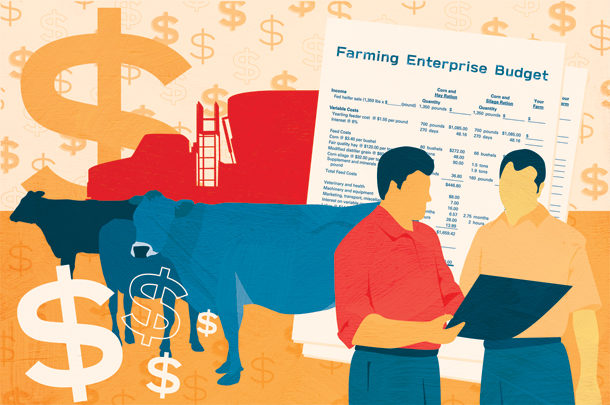The answers to these questions can make or break your farm, but they aren’t impossible to answer. Fortunately, there are tools available that can assist you in determining profitability and can help you improve decisions.
The Center for Profitable Agriculture’s webinar, titled “Budgeting,” by Les Humpal, an extension farm management specialist at the University of Tennessee, covered the importance of budgeting to farming success.
In the second installment of the “Seven Habits for Effective Farmers” webinar series, Humpal focused on major elements of enterprise budgets: purpose, parts and use.
Purpose
“An enterprise budget,” Humpal says, “is an estimate of costs and returns associated with the production of an enterprise.” Each budget allows for estimation of cost, revenue and net returns for the enterprise, which allows for assessment of feasibility and profitability.
Enterprise budgets can also be created as a planning tool. Producers looking to make changes to their operation, such as adding a new enterprise or comparing to see which enterprise could be eliminated, can utilize budgets as a tool to help make their decision.
“If you are not analyzing, you are really missing out on a lot of opportunities to further benefit your farm,” Humpal says. Enterprise budgets are intended to assist in understanding what it takes to produce a product and to determine the true value of an enterprise’s production. If a farm isn’t carefully budgeting for each enterprise, they may be missing valuable information about potential improvement.
Parts
There are different categories that structure enterprise budgets: revenue, variable costs and fixed costs.
Revenue is income from receipts of the enterprise. If enterprises are not yet in production, revenue can be estimated using industry or regional averages of price and yield. If in production, revenue should be known from previous years or production cycles.
Variable costs represent what is utilized during production for the enterprise. If the enterprise was not produced, variable costs would not be incurred. Fixed costs incur even if no production is taking place. Fixed costs may include buildings, equipment, insurance, taxes, etc.
Sometimes costs must be split between variable and fixed. Machinery, for example, is often used across multiple enterprises and would depreciate whether used by an enterprise or not.
Select budgets may also include an opportunity cost consideration. Opportunity cost is loss of benefits that are given to the enterprise that could be applied elsewhere, such as off-farm employment or investments.
Use
Generally, farms don’t produce a single product. Most livestock operations produce animals but also crops or pasture. Most row-crop operations do not grow just a single crop; rather, there are numerous distinct enterprises in each operation.
It is key that an enterprise budget considers each enterprise (e.g., calves, milk, alfalfa) individually. By analyzing each enterprise separately, it allows producers to compare enterprises and can also help with projecting cash flow.
When constructing a budget, enterprises should be based on a unit, such as acres or per animal, and on accurate records. Further, as every farm is run differently, no two budgets will be the same. Generalities should be avoided, and detailed research should be done when compiling production and financial records.
Further, budgets are created based on what resources – land, equipment, labor and capital – are available. Production is restricted to the most limited resource, so budgets should reflect the restrictions of the enterprise.
“Budgets are profit projections – the best estimate, not targets or goals, but what is most likely to happen,” Humpal says. When making decisions based on budgets, realize they are not concrete, but rather approximations of what should happen.
Once an enterprise budget has been constructed, there are many beneficial uses, including:
- Determining break-even prices and yield
- Itemizing income received
- Listing inputs and production practices required
- Evaluating efficiency
- Estimating benefits and costs of major changes in production practices
- Providing basis for a total farm plan
- Supporting applications for credit
“Having accurate information and records allows producers to evaluate different farming enterprises. By breaking it down, they are able to study further and make changes to their operations,” Humpal says.
When the next load of hay has been delivered, and that new check is in your hand, sit down and see how your enterprise is performing. Use your budget and see whether your hard work is paying off or if adjustments are needed to make your enterprise worth your while. ![]()
For more information and access to the webinar, visit “Seven Habits for Effective Farmers.”
Madison Anderson is a 2019 Progressive Forage editorial intern.
PHOTO: Illustration by Kristen Phillips.










